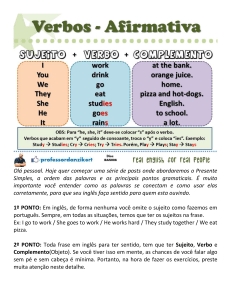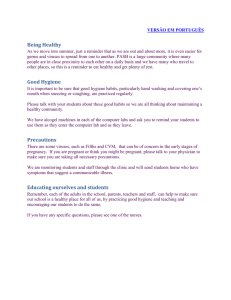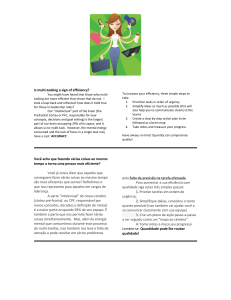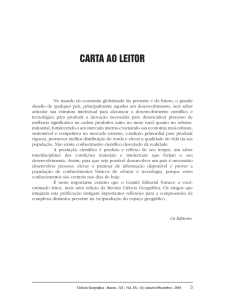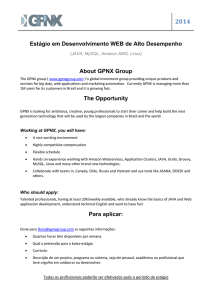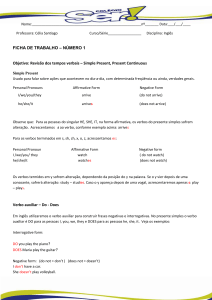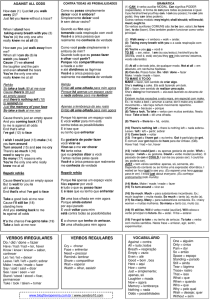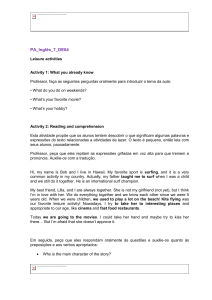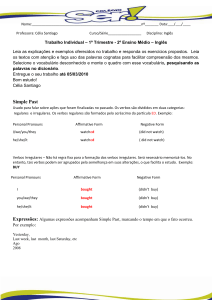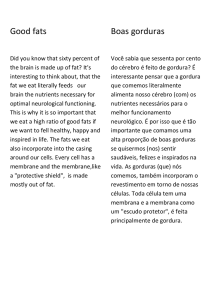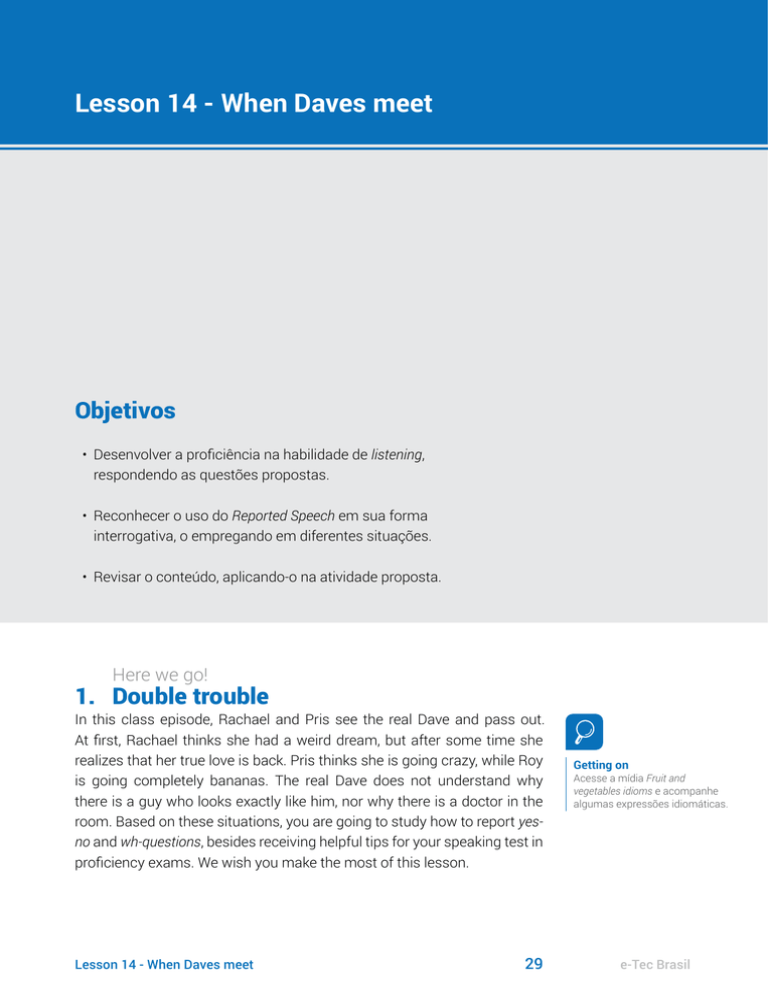
Lesson 14 - When Daves meet
Objetivos
• Desenvolver a proficiência na habilidade de listening,
respondendo as questões propostas.
• Reconhecer o uso do Reported Speech em sua forma
interrogativa, o empregando em diferentes situações.
• Revisar o conteúdo, aplicando-o na atividade proposta.
Here we go!
1. Double trouble
In this class episode, Rachael and Pris see the real Dave and pass out.
At first, Rachael thinks she had a weird dream, but after some time she
realizes that her true love is back. Pris thinks she is going crazy, while Roy
is going completely bananas. The real Dave does not understand why
there is a guy who looks exactly like him, nor why there is a doctor in the
room. Based on these situations, you are going to study how to report yesno and wh-questions, besides receiving helpful tips for your speaking test in
proficiency exams. We wish you make the most of this lesson.
Lesson 14 - When Daves meet
29
Getting on
Acesse a mídia Fruit and
vegetables idioms e acompanhe
algumas expressões idiomáticas.
e-Tec Brasil
Warming up
2. Dave’s alive!
Rachael sees the real Dave and passes out. She is unconscious on the
sofa, and Dave and Dr. Lupov are near her. When she starts waking up, they
try to ask her if she is OK. Watch their conversation:
Dr. Lupov: Rachael, are you alright ?
Dave: Babe?!
Rachael: Hmm... What?
Integrated media
Acesse a mídia Are you alright?
E acompanhe a conversa entre Dave, Rachel e Dr. Lupov.
Learning activity
Real Dave’s back
e-Tec Brasil
Dave: He asked if you're alright.
In order to check your comprehension of what happened in this episode, do
the activity Real Dave’s back. When Dr. Lupov meets Dave, he sees Rachael
on the sofa and asks her is she is OK. She is not completely awake yet, so
Dave says He asked if you’re alright to report what Isaac had said before. In
the following topic you are going to study how to report yes-no questions.
30
English
3. Getting the hang of it
3.1 Reported Speech: yes-no questions:
Na Lesson 13 você estudou como reportar frases ditas anteriormente,
utilizando os verbos say e tell. Nesta aula você estudará como reportar
perguntas e, por isso, o verbo utilizado nesse tipo de Reported Speech será
sempre ask, com sentido de perguntar ou pedir, de acordo com o contexto.
Primeiro, acompanhe a seguir um exemplo de Reported Speech (Discurso
Indireto) em português:
DISCURSO DIRETO – ISAAC
PARA RACHAEL
DISCURSO INDIRETO –
DAVE PARA RACHAEL
Você está bem?
Ele perguntou se você está bem.
Audio
Da mesma forma como acontece ao reportarmos frases afirmativas
ou negativas, o Reported Speech de perguntas ou pedidos também
prevê mudanças no tempo do verbo principal, pronomes e outros itens
linguísticos. Perceba que a pergunta anterior recebe a conjunção se no
Discurso Indireto:
Ele perguntou se você está bem.
Em inglês, a frase equivalente ao exemplo anterior é Are you alright?, que é
um exemplo de yes-no question por iniciar com o verbo auxiliar. Observe:
Yes-no question
Are you alright?
Answer
Yes, I am.
No, I’m not.
Ao colocarmos esta pergunta no Reported Speech, a frase recebe a
conjunção if ou whether (equivalentes a se):
Mind the gap
Neste exemplo não houve
alteração no tempo do verbo
principal por se tratar de um
Reported Speech feito logo
após o Direct Speech.
He asked if you are alright.
Lesson 14 - When Daves meet
31
e-Tec Brasil
Audio
Vale ressaltar que a frase interrogativa do Direct Speech quando colocada no
Reported Speech perde sua estrutura de pergunta, assumindo condição de
frase afirmativa. Veja a estrutura do Direct Speech para frases interrogativas:
subject
Are you alright ?
verb
complement
Agora, observe a estrutura do Reported Speech para a pergunta Are
you alright?
verb
He asked if you are alright.
subject
complement
Acompanhe mais exemplos de Reported Speech – yes-no questions em
outros tempos verbais:
DIRECT SPEECH
REPORTED SPEECH
There to be (presente) → There to be (past)
Are there two Daves?
Portia asked if there
were two Daves
Present Continuous → Past Continuous
Is Roy enjoying the situation?
Present Simple → Past Simple
Mind the gap
Em frases de Reported
Speech, as conjunções if e
whether são equivalentes.
e-Tec Brasil
Pris asked Dr. Lupov if Roy
was enjoying the situation.
Do you believe in robots?
32
Roy asked his sister whether
she believed in robots
English
Observe que, neste último exemplo, o Direct Speech possui o auxiliar do, que
não faz parte da frase no Reported Speech. Além disso, o verbo principal
believe foi conjugado um tempo atrás, ou seja, no Past Simple, conforme a
regra culta gramatical. Veja que o exemplo a seguir utiliza o auxiliar did e
que, também neste caso, o auxiliar não faz parte do Reported Speech:
Audio
Past Simple → Past Perfect
Did you see that?
Pris asked Roy if he had seen that.
Acompanhe outro exemplo de Reported Speech a partir de uma pergunta
no Present Perfect e veja que, assim como no Past Simple, utilizamos o Past
Perfect para formar o discurso indireto:
Present Perfect → Past Perfect
Roy asked Isaac whether
Powell had called him.
Has Powell called you?
Para colocar uma pergunta que no Direct Speech está no Going to – future,
utilizamos o Future in the past, conforme o exemplo a seguir:
Going to → Future in the past
Are you going to tell everybody
about the project?
She asked whether they were going
to tell everybody about the project.
Veja a seguir como funciona a estrutura do Reported Speech a partir de yesno questions com Modal verbs:
Can → Could
Can you get everybody
together to clear things up?
Rachael asked if Dr. Lupov
could get everybody together
to clear things up.
May → Might
May I say something?
Lesson 14 - When Daves meet
Mind the gap
Pris asked if she might
say something.
O modal might, em Reported
Speech, refere-se à permissão.
33
e-Tec Brasil
Will → Would
Will Dave the robot have a
happy ending or not?
Audio
Learning activity
Listen and Report
Reporting with Modals
Roy asked Dr. Lupov whether
Dave the robot would have
a happy ending or not.
Com este conteúdo é possível que você consiga reportar yes-no questions
em diferentes tempos verbais. Para verificar sua aprendizagem, realize as
atividades Listen and Report e Reporting with Modals. No tópico a seguir
você estudará Reported Speech com wh-questions.
3.2 Reported Speech – wh-questions
Antes de estudarmos a estrutura do Discurso Indireto com pronomes
interrogativos em inglês, Veja dois exemplos de perguntas em português,
iniciando com pronomes qual e quem. Observe que, ao colocarmos essas
perguntas no Discurso Indireto, qual e quem continuam fazendo parte
da estrutura:
ISAAC PARA RACHAEL
RACHAEL PARA PRIS
Qual é o problema?
Isaac perguntou qual
era o problema.
DAVE PARA ISAAC
ISAAC PARA POWELL
Quem é aquele cara que
se parece comigo?
Dave perguntou quem era aquele
cara que se parece com ele.
Em língua inglesa essas perguntas são denominadas wh-questions, pois
iniciam com palavras como who ou what. Observe o exemplo anterior,
agora em inglês, com uma possível resposta:
e-Tec Brasil
34
Wh-question
Answer
Who’s that guy that looks
exactly like me?
He’s Dave, the robot.
English
No tópico anterior você estudou Reported Speech para yes-no questions
em diversos tempos verbais, que se aplicam também ao Reported Speech
para wh-questions. Por isso, você agora verá alguns exemplos de Reported
Speech com as question words mais frequentes em alguns dos tempos
verbais estudados anteriormente. Perceba como em todas as frases o
pronome interrogativo permanece:
Audio
What
Direct Speech
Reported Speech
What’s going on here?
Dave asked what was
going on there
Who
Direct Speech
Reported Speech
Who are these people?
Dave asked who those
people were.
Where
Direct Speech
Reported Speech
Where were you?
Rachel asked Dave
where he had been.
When
Direct Speech
Reported Speech
When are you gonna grow up
and quit this robot stuff?
Pris asked Roy when he
was going to grow up and
quit that robot stuff.
How
Direct Speech
Reported Speech
How can we hide this
from the media?
Donavan asked herself
how they could hide
that from the media.
Lesson 14 - When Daves meet
35
e-Tec Brasil
Learning activity
She asked how to report questions!
Com este conteúdo é possível que você consiga se reportar a alguém sobre
algo que foi perguntado ou pedido. Para consolidar seu conhecimento,
realize a atividade She asked how to report questions! No tópico seguinte
você receberá dicas para provas de speaking em exames de proficiência.
Smart point
3.3 Speaking test in proficiency exams – part 2
Na maioria dos exames de proficiência, a prova de speaking é feita de forma
presencial, com um ou mais examinadores. Os modelos de prova são bem
variados como, por exemplo, descrever uma imagem ou argumentar sobre
um tema proposto. Acompanhe algumas dicas importantes para que você
faça sua prova de speaking da melhor maneira possível:
–– preste sempre atenção ao tempo verbal da pergunta, para que
você responda utilizando a conjugação correta dos verbos. Se o
examinador lhe perguntar Where did you spend your last vacation?,
um bom exemplo de resposta seria I spent my last vacation in Europe;
–– caso você não compreenda o que o examinador lhe perguntou,
peça para ele repetir;
–– responda as questões de forma completa e com exemplos, um
simples yes ou no não fornece subsídios suficientes para avaliação.
Para as wh-questions, dê uma resposta mais completa, além de
responder o que lhe foi pedido. Por exemplo, para a pergunta How
many brothers or sisters do you have?, um exemplo de uma boa
resposta seria Two brothers and a sister. Michael is a financial analyst
and lives in Utah, and Brendan is a college professor in Michigan. Susan
is in college, so she still lives with my parentes;
–– se a pergunta for sobre um tópico desconhecido para você, não
tente alongar-se na resposta, correndo o risco de ser incoerente;
–– o ambiente da prova de speaking costuma ser friendly, mas não
sinta-se à vontade demais. Lembre-se que este momento não se
trata de uma conversa entre duas pessoas, e sim de uma pessoa
falando e outra escutando. Tudo que você disser será avaliado de
forma detalhada, para que você receba sua nota de acordo com sua
produção oral;
e-Tec Brasil
36
English
–– utilize estruturas e vocabulário conhecidos, não arrisque clever
words apenas para impressionar os examinadores. Além de correr
o risco de utilizá-las de forma inadequada, você pode perder um
tempo precioso tentando lembrá-las e prejudicar o fluxo de fala.
Com essas dicas você possui mais ferramentas para fazer da sua prova de
speaking um momento de tranquilidade e segurança, com boa probabilidade
de um resultado positivo. Para exercitar as dicas apresentados aqui, realize
a atividade Think before you speak!
Interactive activity
Think before you speak!
Catching a glimpse
4. How to become a stunt
Water skiing and climbing the side of a building are exciting enough for you?
Imagine having these actions as part of your career. If so, maybe being a
stunt may be a good option for you. However, being a stunt is not about
taking risks, but about managing them and staying physically healthy.
Integrated media
Acesse a mídia How to become a
stun e acompanhe o conteúdo.
Developing skills and specializing can definitely help you. If you are an
expert martial artist, gymnast or rock climber, that is great. But the more
you know how to do it, the higher the probabilities that you will be selected
for a job. Some roles require multiple skills, such as fighting, falling, riding
and driving, agility and strength, water skills and several sports. Consider
going to school for specialized training is a very interesting option if you
want to improve your skill set.
Lesson 14 - When Daves meet
37
e-Tec Brasil
Knowing the terms associated with the career is very important, because
if a stunt director starts talking about the job with you, you may know what
he means. Among the main important terms there are wirework, tumbling,
high falls, swordplay, horsework and air ram.
Build your résumé and remember the most important thing: be honest. Do
not try to impress people by saying you have skills you do not really possess,
otherwise you will be in trouble, even in danger. Your height, weight, shoe
size, and any other physical measurements, film and TV credits (if you have
any) and a list of skills or special abilities are some elements that should
be included on your résumé. You may also have a professional black and
white headshot taken and join a Union that is going to represent you and
fight for your rights. That might be mentioned in your résumé as well.
If you get lucky, you can set a gig with a great headshot and impressive
résumé on a non-union project. But if you want to hit the big leagues
and find work on a union project, then you have to obtain a production
list from the union you belong to. These lists contain all of the local union
productions that are shooting near you and all you have to do is send your
headshot and résumé to the stunts coordinator and hope for a phone call
asking: Are you ready to start?
Interactive activity
Mixing up
e-Tec Brasil
After reading this text, do the activity Mixing up to exercise the content
studied in this section.
38
English
5. That’s a wrap!
In this class episode Dave, the famous musician, met Dave the robot. Pris,
Roy and Rachael were all in the room with Dr. Lupov, who will soon have
to explain what happened. All these situations were the starting point
for your lesson, in which you studied Reported Speech for yes-no and whquestions, as well as speaking tips for proficiency exams. After studying
these contents, you are very likely to be able to report what people say and
feel more confident during the speaking test. We hope you make the most
of the lesson by doing all the activities. Keep up the good work!
Lesson 14 - When Daves meet
39
e-Tec Brasil
e-Tec Brasil
40
English

